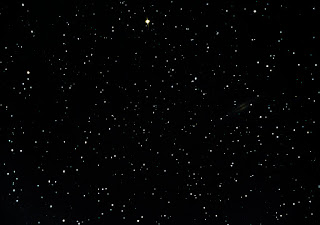A lovely clear night and my first chance to put into place my new set up 'routine' ( well, hopefully to become a routine!).
New Setting Up Routine
1. Mount and tripod taken outside a couple of hours/hour before observing.
2. Telescope attached, collimated, balanced ( mirror very slightly heavy).
3. Polar scope used to align telescope to celestial north (aided by app on smart phone, showing where Polaris should be on a reticule; also use the same app to set time/date).
4. Using eyepiece, two star alignment carried out ( using Arcturus and Mizar - seems to be a limited menu choice, I assume it is recommending suitable stars as opposed to any stars).
5. Add two (or three?) calibration stars; Deneb, Altair and Caph; again, it offers a limited list.
6. Now use the Polar Align routine in Nexstar+; last night the telescope used Deneb; it was almost dead centre anyway, so maybe Polar Scope is good enough?
7. I now replace the eyepiece with my Revelation 2" Barlow and Nikon D5300; Bahtinov mask in place and last night I used Deneb to focus the telescope. I can just about see the three lines used to check focus but I took a photo to check:
8. And now a photo without the Bahtinov mask to see it in all its glory:
READY TO ROCK AND ROLL!!
At an estimate, it took maybe half and hour to set up ( my first time at trying everything in the list).
Targets
I really wanted to see what the effect of all the steps outlined above had on tracking ( still no guider I am afraid). I chose Messier 51 since it was high and is easy to see even on a relatively short exposure. It was not dead centre, but was lower left in the screen, Slightly puzzling, since my normal set up of two star alignment plus two calibration stars ends up with object just about central. Anyway, after a few tentative adjustments I was able to take some pics:
10 x 90 second exposures
210 second exposure (!)
I have been toying with the idea of not bothering with darks and bias, but since I have not tested the effects of using/not using in the dreaded DSS, I decided to shoot some darks and bias. Later I will see the effects of with and without ( remembering this time that DSS does not like DNG files; I need to export as TIFF before loading into DSS. (I am probably going to look at AstroArt 5 since Olly Prentice recommends it).
uh oh.... clouds appearing. So, now change of plan. Instead of exploring why a filter is needed for a good shot of M16 The Eagle Nebula, I slewed the scope to Messier 32 and tried some long and not so long exposures...
Conclusions from the night
Regarding Accuracy of GoTo and Field Of View
According to the
BBC Sky at Night field of View calculator (200mm aperture, 1000mm focal length , 2x Barlow):
F ratio: f10 Focal Length: 2000mm
Field of view:40.54' x 26.92'
Resolution:0.57"/pixel
From the size of M51, this looks about right. So, using those figures, the GoTo accuracy is off by about 15' x 10'. I wonder if this is typical ? (I shall ask in
Stargazers Lounge I think !).
PostScript: Use Sync on a nearby star....not sure about refocussing now (have to remove camera, find star, sync, attach camera, refocus...)






































